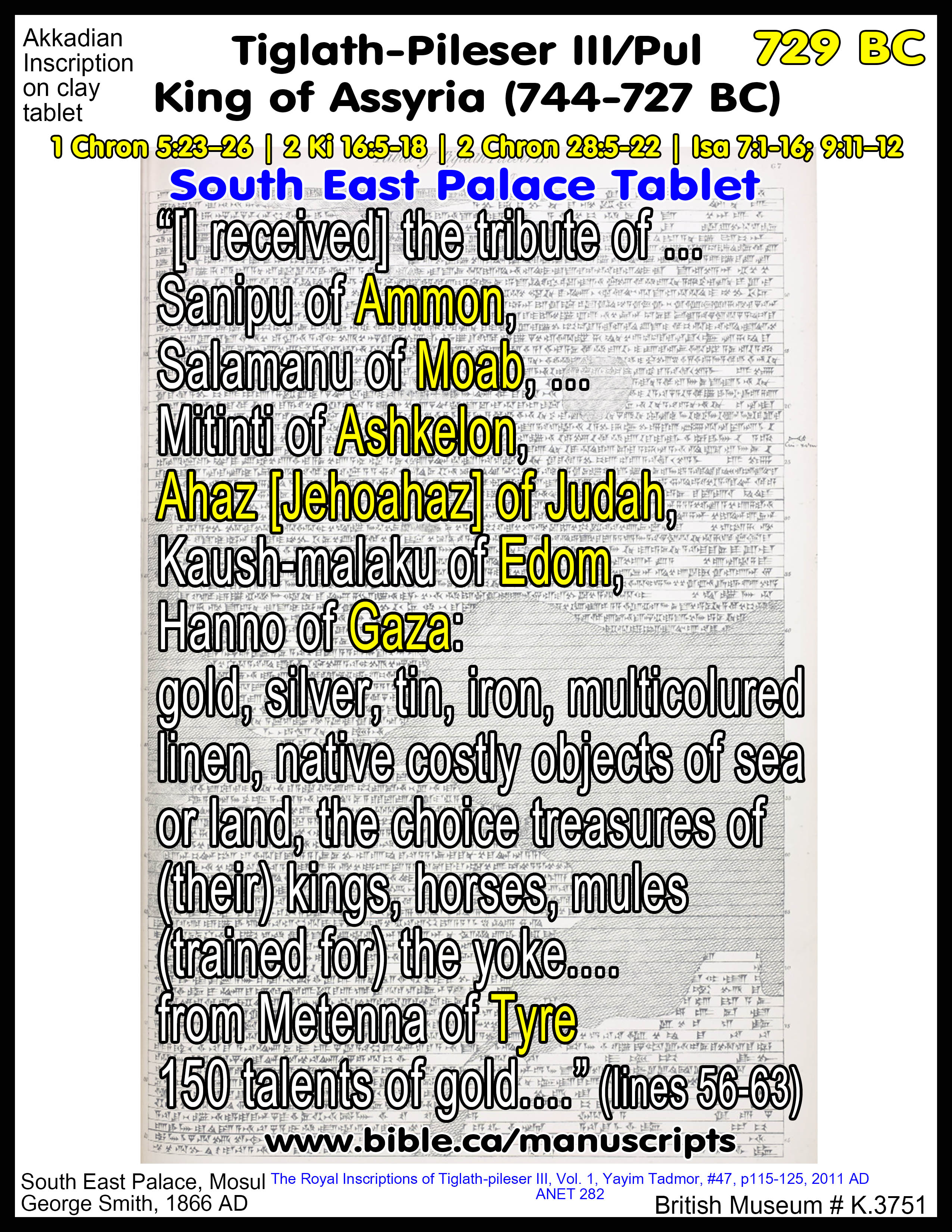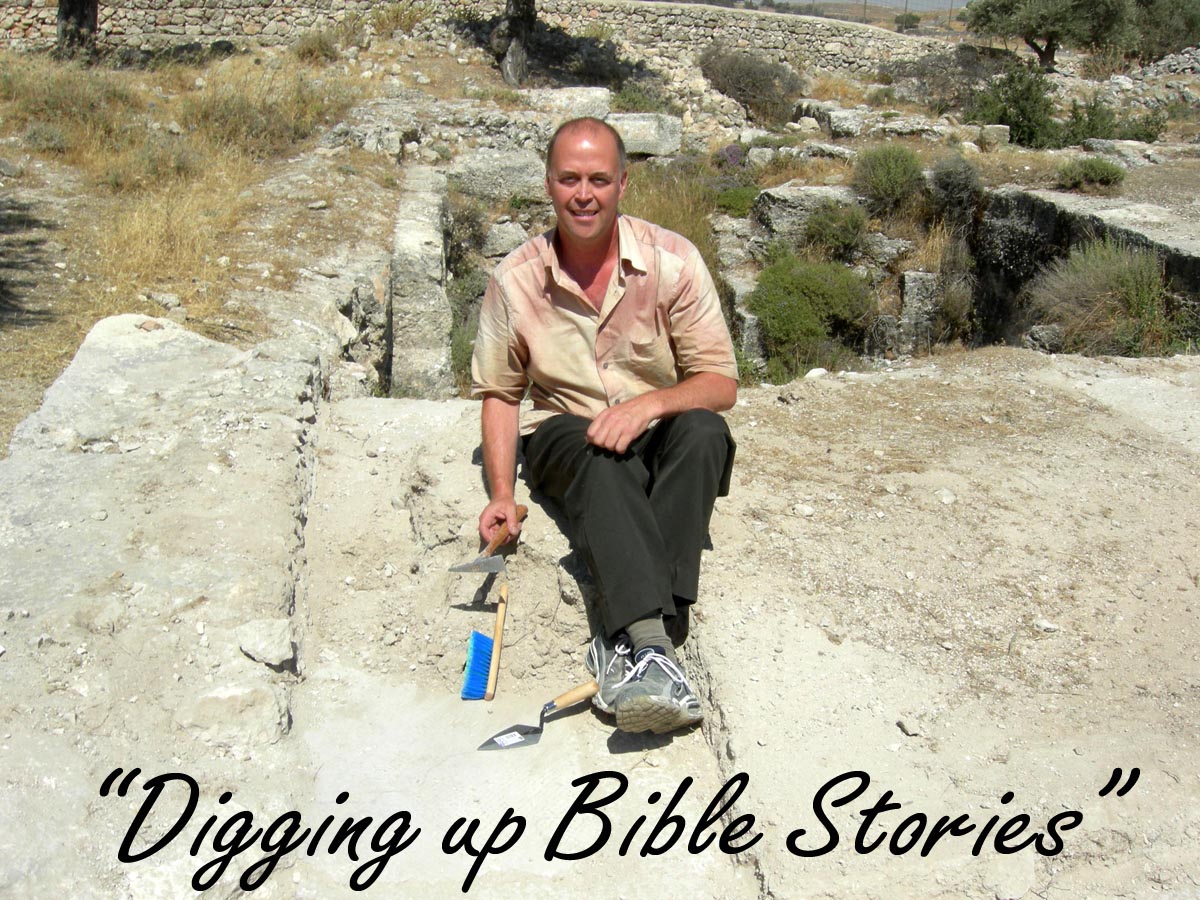Tiglath-Pileser III/Pul (745-727 BC)
Wall
inscription on clay: 732 BC
"I received tribute from Ahaz of Judah"
(ANET, 282)
|
Digging up Bible stories!
"I received tribute from Ahaz of Judah, Edom, Ammon, Moab"
Detailed outline on Edom.
|
Introduction:
- This inscription was found on a wall written on a clay surface.
- From a building inscription on clay preserved in various copies, published by Rawlinson : Cuneiform Inscriptions of Western Asia, H.C. Rawlinson, Bd. II, plate 67, lines 56-63, 1861 AD
- This inscription documents the conquest of Tiglath-Pileser III, also known as Pul, in 723 BC.
- The Bible story told in the inscription: 2 Ki 16:5-18; 2 Chron 28:20
- "For the Lord humbled Judah because of Ahaz king of Israel, for he had brought about a lack of restraint in Judah and was very unfaithful to the Lord. So Tilgath-pilneser king of Assyria came against him and afflicted him instead of strengthening him. Although Ahaz took a portion out of the house of the Lord and out of the palace of the king and of the princes, and gave it to the king of Assyria, it did not help him. Now in the time of his distress this same King Ahaz became yet more unfaithful to the Lord." (2 Chronicles 28:19–22)
- "Then King Rezin of Aram and King Pekah son of Remaliah of Israel came up to wage war on Jerusalem; they besieged Ahaz but could not conquer him. At that time the king of Edom recovered Elath for Edom, and drove the Judeans from Elath; and the Edomites came to Elath, where they live to this day. Ahaz sent messengers to King Tiglath-pileser of Assyria, saying, “I am your servant and your son. Come up, and rescue me from the hand of the king of Aram and from the hand of the king of Israel, who are attacking me.” Ahaz also took the silver and gold found in the house of the Lord and in the treasures of the king’s house, and sent a present to the king of Assyria. The king of Assyria listened to him; the king of Assyria marched up against Damascus, and took it, carrying its people captive to Kir; then he killed Rezin. When King Ahaz went to Damascus to meet King Tiglath-pileser of Assyria, he saw the altar that was at Damascus. King Ahaz sent to the priest Uriah a model of the altar, and its pattern, exact in all its details. The priest Uriah built the altar; in accordance with all that King Ahaz had sent from Damascus, just so did the priest Uriah build it, before King Ahaz arrived from Damascus. When the king came from Damascus, the king viewed the altar. Then the king drew near to the altar, went up on it, and offered his burnt offering and his grain offering, poured his drink offering, and dashed the blood of his offerings of well-being against the altar. The bronze altar that was before the Lord he removed from the front of the house, from the place between his altar and the house of the Lord, and put it on the north side of his altar. King Ahaz commanded the priest Uriah, saying, “Upon the great altar offer the morning burnt offering, and the evening grain offering, and the king’s burnt offering, and his grain offering, with the burnt offering of all the people of the land, their grain offering, and their drink offering; then dash against it all the blood of the burnt offering, and all the blood of the sacrifice; but the bronze altar shall be for me to inquire by.” The priest Uriah did everything that King Ahaz commanded. Then King Ahaz cut off the frames of the stands, and removed the laver from them; he removed the sea from the bronze oxen that were under it, and put it on a pediment of stone. The covered portal for use on the sabbath that had been built inside the palace, and the outer entrance for the king he removed from the house of the Lord. He did this because of the king of Assyria." (2 Kings 16:5–18)
I. Translation of wall relief on clay of Tiglath-Pileser III/Pul (745-727 BC):
- "I installed Idi-bi’li as a Warden of Marches on the border of Musur. In all the countries which … [I received] the tribute of Kushtashpi of Commagene (Kummuḫu), Urik of Qu’e, Sibitti-be’l of Byblos, … Enil of Hamath, Panammu of Sam’al, Tarhulara of Gumgum, Sulumal of Militene, … Uassurme of Tabal, Ushhitti of Tuna, Urballa of Tuhana, Tuhamme of Ishtunda, … [Ma]tan-be’l of Arvad, Sanipu of Bit-Ammon, Salamanu of Moab, … Mitinti of Ashkelon, Jehoahaz (Ia-ú-ḫa-zi) of Judah (Ia-ú-da-a-a), Kaush-malaku of Edom (Ú-du-mu-a-a), Muzr[i … ], Hanno (Ḫa-a-nu-ú-nu) of Gaza (Ḫa-za-at-a-a) (consisting of) gold, silver, tin, iron, antimony [a rare metal], linen garments with multicolored trimmings, garments of their native (industries) (being made of) dark purple wool … all kinds of costly objects be they products of the sea or of the continent, the (choice) products of their regions, the treasures of (their) kings, horses, mules (trained for) the yoke.… (66) I sent an officer of mine, the rabšaq, to Tyre [and received] from Metenna of Tyre 150 talents of gold.…" (ANET, 282)
II. Authorities on Tiglath-pileser III wall inscription:
- "Ahaz is also noted on a building inscription detailing Tiglath-Pileser III’s actions during military campaigns in Syria and Palestine. He is listed among a group who paid tribute to the Assyrian king, and is called by his longer name (Ia-u-ha-zi) or Jehoahaz" (LBD, Ahaz, 2015 AD)
- "Following Tiglath-pileser III’s campaigns in Palestine in 734 bce, Edom, too, came under Assyrian domination. Some of the Assyrian sources deal with the kingdom of Edom, and mention the names of some of its kings and their achievements: for example, the building inscription of Tiglath-pileser III refers to Qosmalku of Edom as one of the kings from whom he received tribute." (Archaeology of the Land of the Bible, V II, Edom, p 268, 2001 AD)
- "Likewise, the Edomite name Kaush-Malak in the building inscription of Tiglath-pileser III (ANET, p. 282a) may mean “King gave.”" (ABD, Elkosh)
- "The Assyrian king Tiglath-pileser III (744–727) claims, in a building inscription, that he received tribute from Kaushmalaku (Qaushmalaku) of Edom. Payment of tribute to Assyria was burdensome and Edom, among other states (but not Judah), was encouraged to revolt by Egypt." (Eerdmans dictionary of the Bible, Edom, 2000 AD)
- "Similarly, the building inscriptions of Tiglath-pileser III, Sargon, Sennacherib, and Esarhaddon conventionally designate their royal houses by their materials: e.g., “Palaces of ivory, maple, boxwood, mulberry, cedar, cypress, juniper, pine and pistachio-wood, I erected herein for my royal dwelling”" (ISBE, Ivory, 1988 AD)
Conclusion:
- This inscription of Tiglath-pileser III gives us the names of the kings of Judah, Ammon, Moab, Edom, Tyre and Gaza, just to name a few.
- What we read in the book, we find in the ground, or in this case in a wall inscription that dates to 723 BC that names Ahaz, King of Judah.
- Sometimes what we find in the ground gives us new information not found in the Bible!
- "The name Ahaz, is a hypocoristicon: a shortened form of names such as Ahaziah and Jehoahaz, “the LORD holds.” These names probably reflect confidence in God’s imminent presence, as in Ps 73:23, “I am always with you, you hold (ʾāḥaztā) my right hand”) (ABD, Ahaz)
- "His name [Ahaz] is probably an abbreviated form of Jeho-ahaz (יְהוֹאָחָז), since it appears on the Assyr. inscriptions as Ia-u-ḫa-zi." (A Dictionary of the Bible: Dealing with Its Language, Literature, and Contents Including the Biblical Theology, Volumes I–V, Ahaz, 1912 AD)
- Stunningly, the inscription gives us the full name of Ahaz where the Bible is silent: Jehoahaz.
By Steve Rudd: Contact the author for comments, input or corrections.


